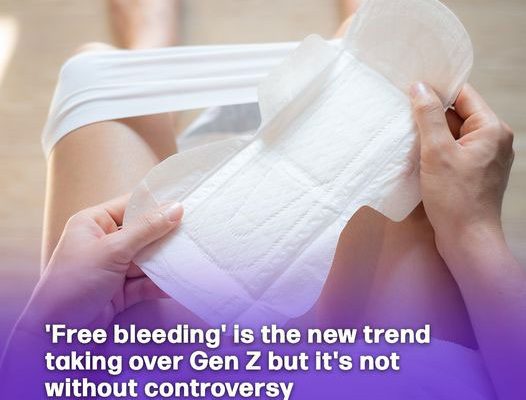Free bleeding is a practice that challenges the conventional approach to menstruation by forgoing the use of traditional menstrual products such as tampons, pads, or cups. While it has gained traction in recent years, it’s more than just a trend—it is a movement rooted in feminist ideals, environmental consciousness, and a desire to destigmatize natural bodily functions. This article delves into 13 key aspects of free bleeding, exploring its origins, cultural impact, and the diverse perspectives that shape its growing prominence.
1. What is Free Bleeding?

Free bleeding refers to the practice of menstruating without using traditional menstrual products like tampons, pads, or menstrual cups. Instead, individuals allow their menstrual flow to occur naturally, without intervention. This practice has garnered attention for challenging societal norms around menstruation and promoting body positivity.
Read More: New Dad Checks His Baby’s Chart And Notices His Baby’s Blood Type Is Incompatible With His
2. The Origins of Free Bleeding

The concept of free bleeding gained significant attention in the early 2010s, particularly through social media movements. However, it’s rooted in a broader historical context of questioning and resisting the commercialization of menstruation, which has been prevalent since the advent of disposable menstrual products in the 20th century.
3. The Influence of Feminism

Free bleeding is often associated with feminist movements that aim to de-stigmatize menstruation. By choosing not to use traditional menstrual products, individuals are making a statement against the idea that periods are something to be hidden or controlled. This aligns with broader feminist goals of challenging societal expectations and embracing natural bodily functions.
4. Environmental Considerations

One of the key motivations behind this choice is its environmental impact. Traditional menstrual products, especially disposable ones, contribute significantly to waste. By opting to free bleed, individuals reduce their environmental footprint, aligning with eco-friendly and sustainable living practices.
5. Health and Hygiene Concerns

There are varying opinions on the health implications of free bleeding. Proponents argue that it’s a natural and healthy way to manage menstruation, while critics raise concerns about hygiene and the potential for discomfort or embarrassment in public settings. It’s essential to understand the individual nature of this practice and consider personal comfort and hygiene preferences.
6. Cultural Reactions and Controversies

Free bleeding has sparked debates and controversy, particularly in Western cultures where menstruation is often viewed as a private matter. The practice challenges deep-seated cultural norms around cleanliness and modesty, leading to mixed reactions ranging from support and admiration to criticism and discomfort.
7. The Role of Social Media in the Movement

Social media has played a crucial role in the rise of the free bleeding movement. Platforms like Instagram and Twitter have provided a space for individuals to share their experiences, challenge taboos, and build communities around body positivity and menstrual health. This visibility has helped to normalize the practice and encourage open discussions about menstruation.
Read More: Man Shamed for Demanding Girlfriend Pay for New Sheets After She Leaked on Them
8. Celebrity Endorsements and Public Figures

Some public figures and celebrities have spoken out in support of free bleeding, using their platforms to advocate for menstrual health awareness and destigmatization. These endorsements have helped to bring the practice into mainstream conversations, further challenging traditional views on menstruation.
9. Economic Factors: Accessibility and Cost

Free bleeding is also seen as a response to the high cost of menstrual products, which can be a significant financial burden for many individuals. By eliminating the need for these products, it offers a cost-effective alternative, particularly for those who face economic barriers to accessing menstrual care.
10. Intersectionality and Inclusivity

The free bleeding movement is inclusive of people from various backgrounds, including those who do not identify as women but still menstruate. This inclusivity is crucial for expanding the conversation about menstruation to include all individuals who experience it, regardless of gender identity.
11. The Global Perspective on Free Bleeding

While free bleeding has gained traction in some parts of the world, cultural attitudes towards menstruation vary globally. In many cultures, menstruation remains highly stigmatized, making practices like this less socially acceptable. Understanding these cultural differences is essential in discussing the global implications of the movement.
12. Management in Sports and Physical Activity

For some athletes and physically active individuals, free bleeding offers a more comfortable and liberating alternative to traditional menstrual products. However, this practice is not without challenges, particularly in high-intensity sports where leakage could be a concern. Athletes who follow this method often share tips and experiences to manage their flow during physical activity.
13. The Future of Choice

As the conversation around menstrual health continues to evolve, it’s likely to remain a significant topic of discussion. The practice challenges conventional wisdom about menstruation and opens the door for more diverse and inclusive approaches to menstrual care. The future of free bleeding will likely see increased acceptance and integration into broader conversations about body positivity, health, and environmental sustainability.
These insights draw from a variety of sources, each offering a unique perspective on the growing free bleeding movement. As awareness and understanding of this practice expand, it continues to spark important conversations about menstruation, body autonomy, and societal norms.




